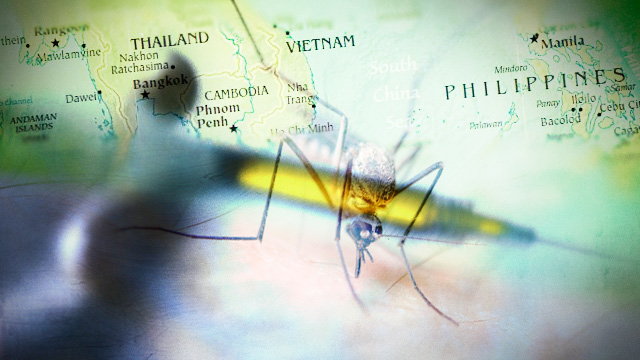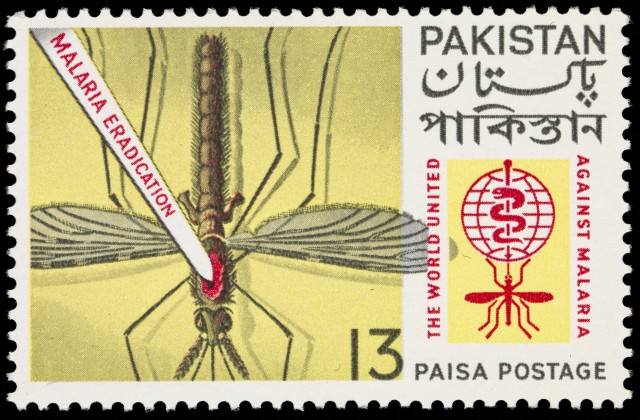
Aurich Lawson
In the war against malaria, one small corner of the globe has repeatedly turned the tide, rendering our best weapons moot and medicine on the brink of defeat. Ed Yong reports from the remote border outpost where scientists are making a last stand.
The meandering Moei River marks the natural boundary between Thailand and Myanmar. Its muddy waters are at their fullest, but François Nosten still crosses them in just a minute aboard a narrow, wooden boat. In the dry season, he could wade across. As he steps onto the western riverbank in Myanmar, he passes no checkpoint and presents no passport.
The air is cool. After months of rain, the surrounding jungle pops with vivid lime and emerald hues. Nosten climbs a set of wooden slats that wind away from the bank, up a muddy slope. His pace, as ever, seems relaxed and out of kilter with his almost permanently grave expression and urgent purpose. Nosten, a rangy Frenchman with tousled brown hair and glasses, is one of the world’s leading experts on malaria. He is here to avert a looming disaster. At the top of the slope, he reaches a small village of simple wooden buildings with tin and thatch roofs. This is Hka Naw Tah, home to around 400 people and a testing ground for Nosten’s bold plan to completely stamp out malaria from this critical corner of the world.
Malaria is the work of the single-celled Plasmodium parasites, and Plasmodium falciparum chief among them. They spread between people through the bites of mosquitoes, invading first the liver, then the red blood cells. The first symptoms are generic and flu-like: fever, headache, sweats and chills, vomiting. At that point, the immune system usually curtails the infection. But if the parasites spread to the kidneys, lungs, and brain, things go downhill quickly. Organs start failing. Infected red blood cells clog the brain’s blood vessels, depriving it of oxygen and leading to seizures, unconsciousness, and death.
When Nosten first arrived in Southeast Asia almost 30 years ago, malaria was the biggest killer in the region. Artemisinin changed everything. Spectacularly fast and effective, the drug arrived on the scene in 1994, when options for treating malaria were running out. Since then, “cases have just gone down, down, down,†says Nosten. “I’ve never seen so few in the rainy seasonâ€"a few hundred this year compared to tens of thousands before.â€
But he has no time for celebration. Artemisinin used to clear P. falciparum in a day; now, it can take several. The parasite has started to become resistant. The wonder drug is failing. It is the latest reprise of a decades-long theme: we attack malaria with a new drug, it mounts an evolutionary riposte.
Back in his office, Nosten pulls up a map showing the current whereabouts of the resistant parasites. Three colored bands highlight the borders between Cambodia and Vietnam, Cambodia and Thailand, and Thailand and Myanmar (Burma). Borders. Bold lines on maps, but invisible in reality. A river that can be crossed in a rickety boat is no barrier to a parasite that rides in the salivary glands of mosquitoes or the red blood cells of humans.
History tells us what happens next. Over the last century, almost every frontline antimalarial drugâ€"chloroquine, sulfadoxine, pyrimethamineâ€"has become obsolete because of defiant parasites that emerged from western Cambodia. From this cradle of resistance, the parasites gradually spread west to Africa, causing the deaths of millions. Malaria already kills around 660,000 people every year, and most of them are African kids. If artemisinin resistance reached that continent, it would be catastrophic, especially since there are no good replacement drugs on the immediate horizon.
Nosten thinks that without radical measures, resistance will spread to India and Bangladesh. Once that happens, it will be too late. Those countries are too big, too populous, too uneven in their health services to even dream about containing the resistant parasites. Once there, they will inevitably spread further. He thinks it will happen in three years, maybe four. “Look at the speed of change on this border. It’s exponential. It’s not going to take 10 or 15 years to reach Bangladesh. It’ll take just a few. We have to do something before it’s too late.â€
Hundreds of scientists are developing innovative new ways of dealing with malaria, from potential vaccines to new drugs, genetically modified mosquitoes to lethal fungi. As Nosten sees it, none of these will be ready in time. The only way of stopping artemisinin resistance, he says, is to completely remove malaria from its cradle of resistance. “If you want to eliminate artemisinin resistance, you have to eliminate malaria,†says Nosten. Not control it, not contain it. Eliminate it.
That makes the Moei River more than a border between nations. It’s Stalingrad. It’s Thermopylae. It’s the last chance for halting the creeping obsolescence of our best remaining drug. What happens here will decide the fate of millions.
§
The world tried to eliminate malaria 60 years ago. Malaria was a global affliction back then, infecting hundreds of thousands of troops during World War II. This helped motivate a swell of postwar research. To fight the disease, in 1946 the US created what is now the Centers for Disease Control and Prevention (CDC), the country’s premier public health institute. After a decisive national eradication program, the nation became malaria-free in 1951. Brazil had also controlled a burgeoning malaria epidemic with insecticides.
Meanwhile, new weapons had emerged. The long-lasting insecticide DDT was already being widely used and killed mosquitoes easily. A new drug called chloroquine did the same to Plasmodium. Armed with these tools and buoyed by earlier successes, the World Health Organization formally launched the Global Malaria Eradication Programme in 1955. DDT was sprayed in countless homes. Chloroquine was even added to table salt in some countries. It was as ambitious a public health initiative as has ever been attempted.

Wellcome Library
It worked to a point. Malaria fell dramatically in Taiwan, Sri Lanka, India, the Caribbean, the Balkans, and parts of the South Pacific. But ultimately the problem was too big, the plan too ambitious. It barely made a dent in sub-Saharan Africa, where public health infrastructure was poor and malaria was most prevalent. And its twin pillars soon crumbled as P. falciparum evolved resistance to chloroquine, and mosquitoes evolved resistance to DDT. The disease bounced back across much of Asia and the western Pacific.
In 1969, the eradication program was finally abandoned. Despite several successes, its overall failure had a chilling impact on malaria research. Investments from richer (and now unaffected) countries dwindled, save for a spike of interest during the Vietnam War. The best minds in the field left for fresher challenges. Malaria, now a tropical disease of poor people, became unfashionable.
No comments:
Post a Comment